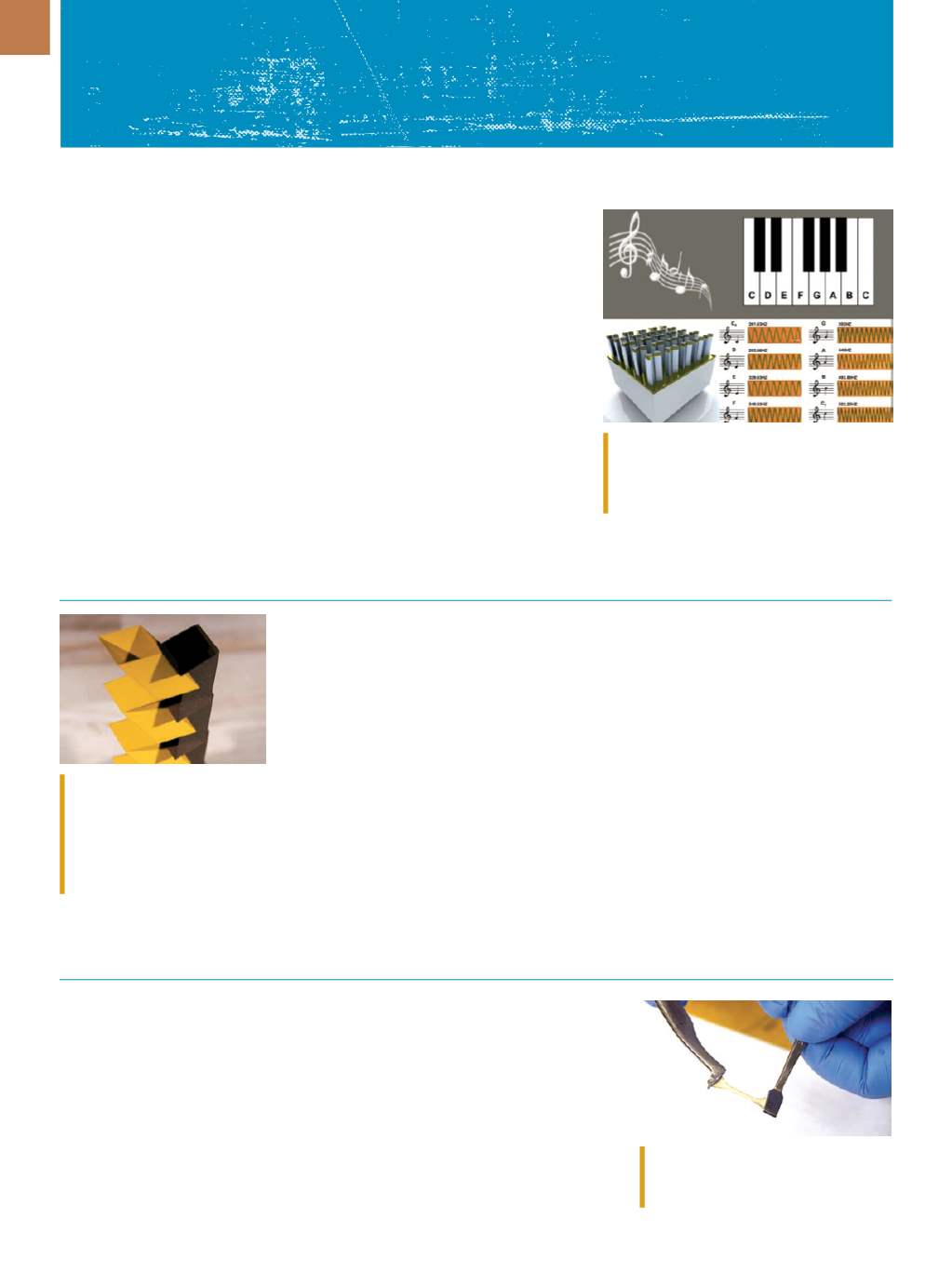

A D V A N C E D M A T E R I A L S & P R O C E S S E S | O C T O B E R 2 0 1 5
100
STRESS RELIEF
NANO PIANO AMPS UP DATA STORAGE
Researchers from the University of Illinois at Urbana-Champaign demonstrat-
ed the first-ever recording of optically encoded audio onto a nonmagnetic plas-
monic nanostructure, opening the door to multiple uses in information process-
ing and storage. “The chip’s dimensions are roughly equivalent to the thickness
of human hair,” says Kimani Toussaint, associate professor of mechanical science
and engineering. Specifically, the photographic film property exhibited by an ar-
ray of gold, pillar-supported bowtie nanoantennas (pBNAs)—previously discovered
by Toussaint’s group—was exploited to store sound and audio files. Compared
with conventional magnetic film for analog data storage, the capacity of pBNAs is
around 5600 times larger.
Researchers demonstrated that the pBNAs could be used to store sound in-
formation either as a temporally varying intensity waveform or a frequency varying
intensity waveform. Eight musical notes were stored on a pBNA chip and then re-
trieved and played back. Researchers recorded audio signals by using amicroscope
to scan a sound-modulated laser beam directly on their nanostructures. Retrieval and playback is achieved by using the same
microscope to image the recorded waveform onto a digital camera, whereby simple signal processing can be performed.
For more
information: Kimani Toussaint, 217.244.4088,
ktoussai@illinois.edu, www.illinois.edu.
SQUID TEETH INSPIRE SELF-HEALING MATERIAL
Scientists at the University of Pennsylvania, Philadelphia, are studying the teeth of
cephalopods in order to create a material that heals when water is present, in the same
way that a squid’s teeth do. Researchers reproduced the type of proteins found in the
self-healing teeth and then triggered bacteria to make them in a lab environment. To test
the newmaterial’s strength, the team created a dog-bone shaped sample of the polymer
and then cut it in half. Using warm water at about 113°F and a slight amount of pressure
with a metal tool, the two halves reunited to reform the dog-bone shape. Strength tests
show that the healed material is just as strong as the original part. This type of material
could be used to coat products such as deep-sea Internet cables or perhaps help biomed-
ical devices achieve longer lifespans.
upenn.edu.
USING ORIGAMI TO BUILD BRIDGES?
A new “zippered tube” origami configuration makes paper structures stiff enough to hold
weight yet able to fold flat for easy shipping and storage. Origami structures would be useful in
many engineering and everyday applications, such as a robotic arm that could reach out and
scrunch up, a construction crane that could fold to pick up or deliver a load, or pop-up furniture.
Glaucio Paulino, professor at Georgia Tech, sees particular potential for quick-assembling emer-
gency shelters, bridges, and other infrastructure in the wake of a natural disaster.
Researchers used a particular origami technique called Miura-ori folding. Precise, zig-zag
folded strips of paper are made and then two strips are glued together to make a tube. While the
single strip of paper is highly flexible, the tube is stiffer and does not fold in as many directions.
Researchers tried coupling tubes in different configurations to see if that added to the struc-
tural stiffness of the paper structures and found that interlocking two tubes in zipper-like fash-
ion made them much stiffer and harder to twist or bend. The structure folds up flat, yet rapidly
and easily expands to the rigid tube configuration. Paper prototypes were used to demonstrate
how a thin, flexible sheet can be folded into functional structures, but the techniques could be applied to other thin materials.
Larger-scale applications could combine metal or plastic panels with hinges.
For more information: Glaucio Paulino, 404.385.3996,
glaucio.paulino@ce.gatech.edu,
www.gatech.edu.
“Zippered tube” configuration
makes paper structures stiff
enough to hold weight yet able
to fold flat for easy shipping and
storage. Courtesy of Rob Felt/
Georgia Tech.
Nano piano: Arrays of gold, pillar-supported
bowtie nanoantennas (bottom left) can be used
to record distinct musical notes, as shown in these
dark-fieldmicroscopy images (bottom right).
A new kind of self-healing plastic inspired
by squid teeth can heal itself with water.
Courtesy of Demirel Lab/Penn State.


















